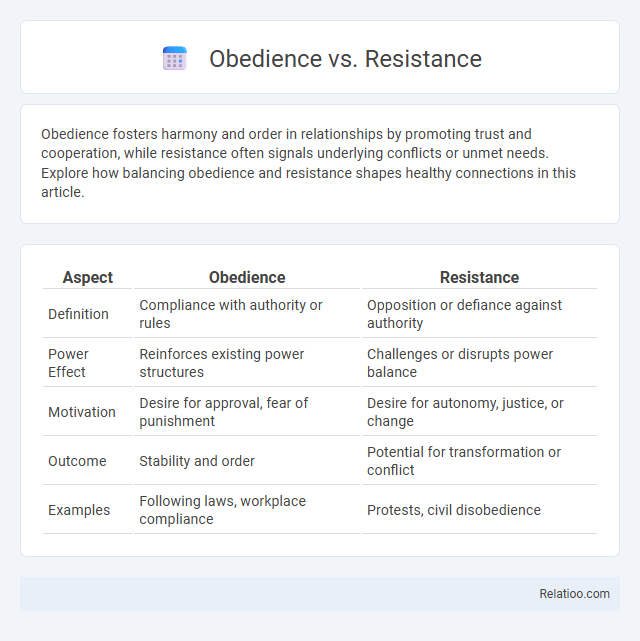Obedience fosters harmony and order in relationships by promoting trust and cooperation, while resistance often signals underlying conflicts or unmet needs. Explore how balancing obedience and resistance shapes healthy connections in this article.
Table of Comparison
| Aspect | Obedience | Resistance |
|---|---|---|
| Definition | Compliance with authority or rules | Opposition or defiance against authority |
| Power Effect | Reinforces existing power structures | Challenges or disrupts power balance |
| Motivation | Desire for approval, fear of punishment | Desire for autonomy, justice, or change |
| Outcome | Stability and order | Potential for transformation or conflict |
| Examples | Following laws, workplace compliance | Protests, civil disobedience |
Understanding Obedience: Definition and Origins
Obedience refers to the act of following orders or instructions from an authority figure, often rooted in social and psychological mechanisms that promote conformity and control. Its origins trace back to studies in social psychology, such as Stanley Milgram's experiments demonstrating individuals' willingness to comply with authority despite moral dilemmas. Understanding obedience involves analyzing the balance between individual autonomy and external influence within hierarchical structures.
Defining Resistance: Types and Motivations
Resistance involves actions or attitudes opposing authority, norms, or control, often stemming from a desire for autonomy, justice, or personal values. Types of resistance range from passive noncompliance, such as silent dissent or avoidance, to active rebellion, including protests and civil disobedience. Understanding your motivations--whether ideological commitment, perceived injustice, or self-preservation--helps clarify the nature and effectiveness of resistance in different contexts.
Historical Perspectives on Obedience and Resistance
Historical perspectives on obedience often highlight the role of authority in shaping social order, with seminal studies like Milgram's experiments demonstrating how individuals comply with commands despite moral conflicts. Resistance has been documented as both individual defiance and organized movements against oppressive regimes, exemplified by acts of civil disobedience in the civil rights movement and anti-colonial struggles. Deference historically implies voluntary submission to hierarchical structures, reinforcing societal norms and power dynamics through cultural rituals and institutional practices.
Psychological Theories Behind Obedience
Psychological theories behind obedience emphasize the influence of authority figures on individual behavior, as demonstrated in Milgram's obedience experiments where participants followed harmful orders due to perceived legitimate power. Social identity theory explains this obedience through group membership and the desire to maintain social harmony, while cognitive dissonance theory highlights the discomfort experienced when actions conflict with personal beliefs, often resolved by justifying obedience. Understanding these psychological mechanisms can help you recognize when your compliance is driven by social pressures rather than autonomous choice, distinguishing it from resistance or deference.
Factors Influencing Acts of Resistance
Factors influencing acts of resistance include perceived legitimacy of authority, individual moral values, and the level of social pressure exerted by groups. Psychological elements such as fear of punishment, desire for social approval, and cognitive dissonance also shape decisions to resist or comply. Contextual variables like cultural norms, past experiences with authority, and the availability of alternative actions further determine the likelihood of resistance.
Social Consequences of Obedience
Obedience to authority often leads to compliance with social norms, but it can also result in negative social consequences such as loss of personal autonomy and moral disengagement. Your willingness to obey authority figures may cause tension or conflict when obedience conflicts with individual values or ethical standards. Understanding the social dynamics of obedience helps navigate the balance between conformity and resistance in group settings.
Moral and Ethical Dimensions of Resistance
Moral and ethical dimensions of resistance emphasize the justification of opposing unjust authority to uphold human rights and dignity. Resistance challenges obedience by asserting moral autonomy when compliance contradicts personal or societal ethical standards. Your ethical responsibility may compel deference to authority only when it aligns with justice, making resistance a crucial act of moral integrity.
Case Studies: Obedience vs Resistance in Society
Case studies reveal obedience often emerges in hierarchical structures where authority commands compliance, such as Stanley Milgram's experiments demonstrating high rates of obedience despite moral conflict. Resistance surfaces in social movements like the Civil Rights Movement, where individuals oppose unjust laws through organized protests. Deference, distinct from obedience, involves respectful acknowledgment of authority without automatic compliance, evident in diplomatic protocols and cultural traditions.
Balancing Authority and Individuality
Balancing authority and individuality requires understanding the dynamics between obedience, resistance, and deference within relationships and organizations. You can foster a respectful environment by encouraging constructive resistance that challenges unfair rules while maintaining deference to legitimate authority. This approach promotes personal autonomy without undermining the structure necessary for effective collaboration and decision-making.
Lessons Learned: The Importance of Critical Thinking
Understanding obedience, resistance, and deference reveals the crucial role of critical thinking in navigating social and authority dynamics effectively. Lessons learned emphasize that unquestioned obedience can lead to ethical lapses, while resistance often requires informed judgment to challenge unjust directives appropriately. Deference, when balanced with critical analysis, allows respectful engagement without sacrificing personal or moral autonomy.

Infographic: Obedience vs Resistance
 relatioo.com
relatioo.com